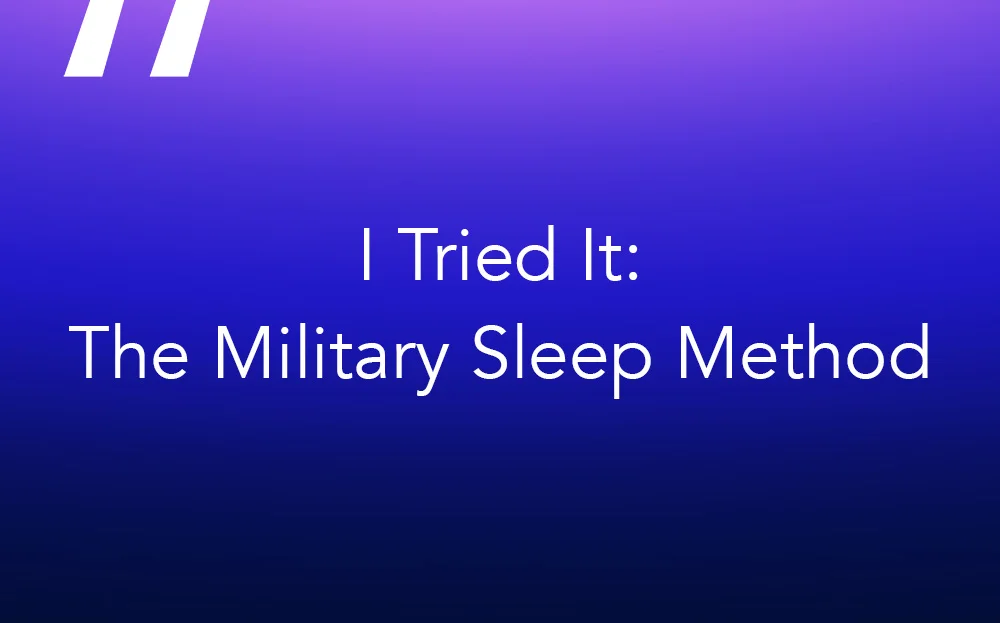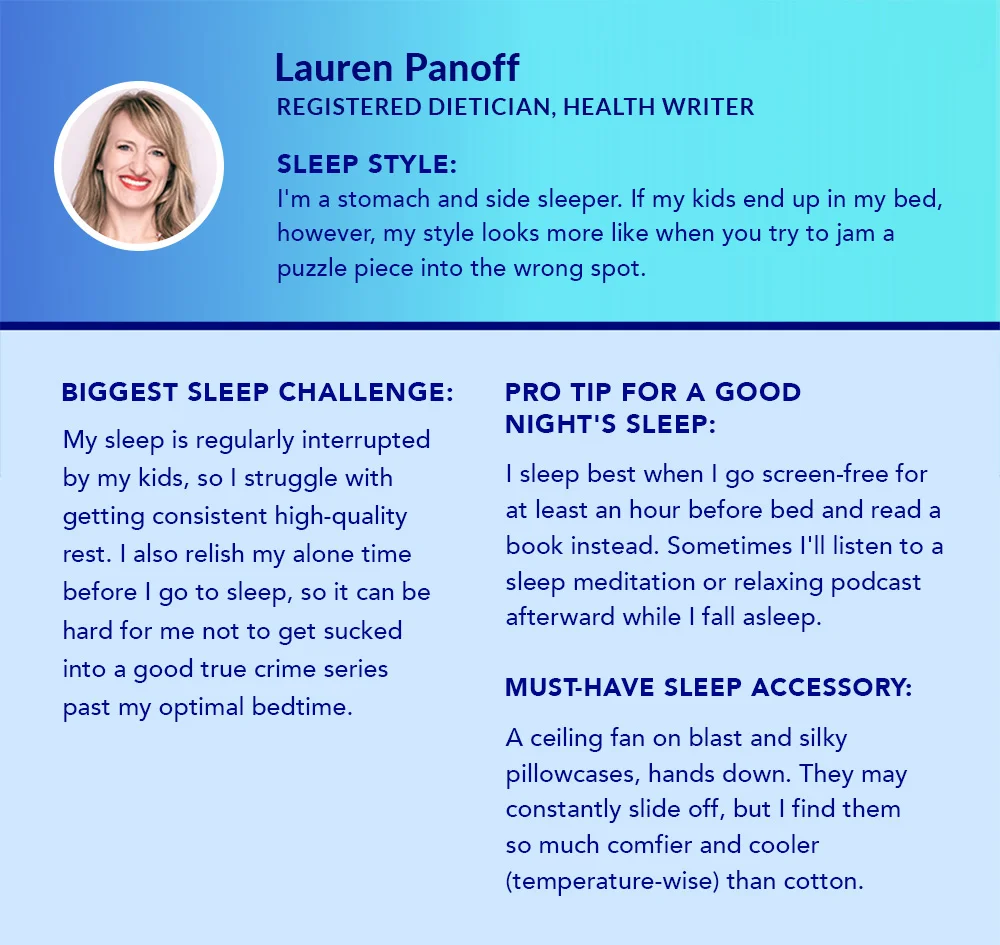
These days, many people are turning to TikTok and other social media platforms for trending sleep advice. One such trend is the military sleep method, which is intended to train your body to fall asleep within two minutes.
I decided to test this theory by trying the hack every night for one week. Here’s what I learned.
Note: The content on Sleepopolis is meant to be informative in nature, but it shouldn’t be taken as medical advice, and it shouldn’t take the place of medical advice and supervision from a trained professional. If you feel you may be suffering from any sleep disorder or medical condition, please see your healthcare provider immediately.
Long Story Short
- The Military Sleep Hack is meant to help you fall asleep within two minutes, a goal that’s supposedly almost guaranteed to be reached if you do it nightly for at least six weeks.
- It works by systematically relaxing and shutting down your body parts, from head to toe, and putting you into a meditative state.
- In my experience, this hack helped me be more attuned to my body and mind before I fell asleep, but it would work best for people who have minimal nighttime distractions and can do it consistently for many weeks.
What Is the Military Sleep Method?
The military sleep method, also sometimes called the military sleep hack, is purportedly a tactic developed to help soldiers fall asleep anywhere and at any time. It was made popular by the military, detailed in the 1981 book Relax and Win: Championship Performance by Lloyd Bud Winter, and largely shared with the rest of the world through social media.
Given the unpredictability and highly stressful environments experienced by military personnel, it makes sense that such a practice would be shared to optimize sleep as much as possible.
Of course, you don’t have to be a soldier to try the military sleep hack and see if it increases your restfulness.
Similar to an instructional sleep meditation you might listen to, this hack works by systematically relaxing all of your body’s individual parts, from head to toe.
While there may not be extensive peer-reviewed research specifically focusing on the “military sleep method” as detailed in social media and popular literature, the principles it employs, such as systematic relaxation and meditation, are supported by research in the context of improving sleep quality and reducing the time it takes to fall asleep. I explored mentions on social media and interviews with sleep experts to understand how it’s meant to work. Some say it will help 96 percent of people fall asleep within two minutes every night as long as they’ve been practicing the habit consistently for six weeks. If that sounds intriguing, read on.
How to Use the Military Sleep Method
There are three basic things to remember when using the military sleep hack.
1. Systematically Relax Your Muscles.
This means relaxing every muscle in your body individually, from head to toe. Focus on that muscle and fully allow it to relax into your bed before moving on to the next one. For example, start with the muscles in your forehead, then move on to your eyes, cheeks, jaw, neck and shoulders, arms, hands, fingers, stomach, thighs, lower legs, feet, ankles, and toes (if you’re still awake when you get down there).
As you’re doing this, you’re supposed to imagine a warm sensation moving from the top of your head to your fingertips and down through your toes.
2. Focus on Your Breathing.
As you systematically relax your muscles, continue to breathe slowly and deeply. Be mindful of the air moving into and out of your lungs.
3. Clear Your Head.
This one can be hard, given how much the mind can wander in the quiet. Advocates recommend envisioning two very specific images to help: (1)
- Lying in a canoe surrounded by calm, clear lake water and nothing but the blue sky above you
- Lying in a black velvet hammock in a pitch-black room
If you find yourself adding other details to your imagery or starting to get distracted, you’re supposed to repeat the words “don’t think” for 10 seconds to recenter. (1)
If this sounds a little “woo-woo,” well, studies have shown that progressive muscle relaxation, guided imagery, and deep breathing successfully increase participants’ states of relaxation (2). And that’s pretty much what this is.
If you’re looking for more strategies on calming your mind before bed, check out these articles:
My Experience Trying the Military Sleep Method at Home

I tried the military sleep hack for myself every night for one week to see if I could experience what all the advocates have been raving about.
In full transparency, I’m a single mom of two small humans who often sleep like garbage, plus a dog who takes up half the bed. How this method worked for me could be wildly different for someone in another season of life or who generally experiences fewer nightly disruptions, although I was pleasantly surprised by my results.
Trying the military sleep hack reminded me of my favorite yoga pose: shavasana (AKA corpse pose). This pose occurs at the end of certain yoga sessions, and many instructors tell you to consciously release parts of your body until you reach a deep state of relaxation.
It’s supposed to help rejuvenate your body, mind, and spirit, increase mindfulness, and alleviate stress and tension. But let’s be honest; if you leave me lying there long enough, I’ll fall asleep.
The first two nights I tried this hack were admittedly difficult — not because it is hard, but because my mind regularly has 78 different browser tabs open. The biggest obstacle to successfully doing this hack is quieting your mind so you can eventually fall asleep in two minutes.
My mid-week attempts were easier as I became more used to the routine. I found the black velvet hammock imagery to be particularly helpful, and surprisingly, I only had to use the “don’t think” repetition twice throughout the week. I don’t recall using the hack for long on a couple of these nights, so it must have worked quickly.
By day seven, I was looking forward to my systematic relaxation. I had inserted it as part of my nightly routine — after reading my book, I’d shut off the light, say my prayers, get cozy, and start with my forehead and eyebrow muscles.
I never reached the two-minute sleep goal, but I only did this for a week instead of the recommended six. With the addition of the hack, I could generally fall asleep in under 15 minutes as long as there were no disruptions. While this isn’t significantly faster than my usual sleep time (15-20 minutes unless I’m exhausted), I did feel more clear-headed and relaxed before I passed out.
The military sleep hack can be a great refocusing and calming tool. While it may not work for everyone, it may help you become more intentional about relaxing your mind and body before bed.
Three Takeaways From the Testing Experience
Practicing Good Sleep Hygiene Still Matters
The military sleep hack isn’t a quick fix for sleep, and it doesn’t work well if it’s the only thing you’re relying on. Sleep hygiene is still super important.
Sleep hygiene refers to the habits you practice regularly to improve your overall sleep pattern, like: (3)
- Going to bed and waking up around the same times every day
- Creating a sleep-promoting space in your bedroom
- Use white noise or blackout curtains if you need them
- Avoiding blue light emitting screens close to bed to reduce melatonin disruption (4)
- Only use your bed for sleep and sex
Even if you find the military sleep method helpful, it probably won’t work as well if you aren’t tired or if you’ve had a screen in your face until the second you lie down. Pair the hack with good sleep hygiene, and I think you can set yourself up for a pretty enviable routine.
The Military Sleep Method May Require Some Strategy
I only have a few hours between putting my kids to bed and when they wake up again. If I want to fall asleep quickly and get the most out of my rest, I’d better schedule my bedtime hacks accordingly.
If you have similar predictable disruptions at night, using the military sleep hack may also need to be strategic. Planning to use it to fall asleep around these disruptors may help you get the most out of your rest overall.
This Hack May Just Help With Mental Health
As a dietitian, I often discuss the importance of mindfulness when eating. Mindfulness is being present and attuned to our bodies to meals and snacks, such as noticing how food feels and tastes when we eat it.
The military sleep hack encourages the same concept of mindfulness at bedtime, which has broader benefits for mental health.
Practicing “turning off” one part of the body at a time allows you to fully present how you feel physically and mentally, at least briefly. I’m not a sleep scientist, but I wonder if doing this before dozing off helps your brain more effectively organize and repair things while you sleep. After all, mindfulness meditation has been shown to help improve sleep quality among some people, which feels like a similar process. (5)
With all the hustle and bustle around us, I believe anything that can help us become more connected to our bodies is crucial — and the military sleep hack is a simple approach.
The Last Word from Sleepopolis
If you have trouble clearing your mind and relaxing your body at bedtime, the military sleep hack may be worth a shot. It can take several attempts before it starts to feel comfortable, and you might even look forward to it. Advocates say you won’t achieve that two-minute sweet spot until you’ve done six weeks of consistent hacking. Still, this simple way to become more present and mindful at night may be a total game-changer in your restfulness.


























